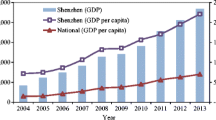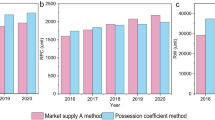Abstract
To examine an appropriate recycling system for end-of-life vehicles (ELVs) from Japan in the context of Asia, an Asian international automobile recycling input-output (AI-ARIO) analysis is presented. The AI-ARIO analysis spatially expands the existing ARIO analysis within the framework of the waste input-output (WIO) analysis developed by Nakamura et al., which considers the interdependence between the flow of goods and wastes in a country. This analysis focuses on the local and global cycles for ELVs in Asia and can evaluate the environmental and economic effects of alternative recycling systems. We estimated the AI-ARIO table for Japan and Thailand and applied it to scenario analyses covering the restriction of ELV trade between the two countries, the introduction of new recycling techniques in Thailand, and centralized treatment in Japan. We verified the applicability and effectiveness of the AI-ARIO analysis through the scenario analyses.
Similar content being viewed by others
References
Terazono A, Yoshida A, Yang J, Moriguchi Y, Sakai S (2003) Material cycles in Asia: especially the recycling loop between Japan and China. J Mater Cycles Waste Manag 6:82–96
Yoshida A, Terazono A, Aramaki T, Hanaki K (2005) Secondary materials transfer from Japan to China: destination analysis in China. J Mater Cycles Waste Manag 7:8–15
Japan Automobile Manufacturers Association (2007) The motor industry of Japan: 2006. JAMA, Tokyo
Clerides S (2005) Gains from trade in used goods: evidence from the global market for automobiles. Discussion paper no. 4859, Centre for Economic Policy Research, London
Pelletiere D, Reinert K (2006) World trade in used automobiles: a gravity analysis of Japanese and US exports. Asian Econ J 20:161–171
Fuse M, Yagita H, Inaba A (2006) The flow of products and materials from Japan for reuse and recycling in Asia focusing on the automobile. In: Proceedings of the Seventh ICEB, International Conference on Eco Balance. Non-Traditional Technology, Tokyo, pp 789–790
Fuse M, Yagita H, Nakajima K (2007) Outflow of resources from Japan focusing on end-of-life vehicles. Mater Trans 48:2436–2444
Quang N, Yamasue E, Okumura H, Ishihara K (2006) Wastes electronic and electric equipment (WEEE) recycling system in Vietnam: a case study on copper recycling. In: Proceedings of the Second SEE, International Conference on Sustainable Energy and Environment. Sustainable Energy and Environment Forum, Bangkok, pp 998–1001
Streucher-Porte M, Bader H, Scheidegger R, Kytzia S (2007) Material flow and economic analysis as a suitable tool for system analysis under the constraints of poor data availability and quality in emerging economies. Clean Technol Environ Policy 9:325–345
Ministry of the Environment, Japan (2006) Final report of the global environment research fund (in Japanese). H-4, The Ministry, Tokyo
Pelletiere D, Reinert K (2002) The political economy of used automobile protection in Latin America. World Econ 25:1019–1037
Pelletiere D, Reinert K (2004) Used automobile protection and trade: gravity and ordered probit analysis. Emp Econ 29:737–751
Fuse M, Kashima S (2005) Creation of the automobile recycling input-output table (in Japanese). J Waste Manag Experts 8:508–519
Fuse M, Kashima S, Yagaita H (2006): Input-output analysis of automobile recycling (in Japanese). J Life Cycle Assess 2:65–72
Nakamura S, Kondo Y (2002) Input-output analysis of waste management. J Ind Ecol 6:39–63
McDougall ML (2001) Solid waste management models: a state of the art review. J Solid Waste Technol Manag 23:73–83
The WIO table for Japan 1995: http://www.f.waseda.jp/nakashin/WIO.html, January 18, 2005
Institute of Developing Economies, Japan (2001) IDE statistical data series no. 90: Asian international input-output table 1995. The Institute, Chiba
The Japan Environmental Management Association for Industry (2005) JEMAI-LCA. The Association, Tokyo
Download service of the Trade Statistics of Japan provided by Japan Customs: http://www.customs.go.jp/toukei/info/index_e.htm, November 3, 2006
Fuse M (2005) Development of evaluation method of a wide area automobile recycling system in East Asia. Doctoral thesis, Chuo University
Keio Economic Observatory (2002) Creation and application of economic development and environmental navigator (EDEN) (in Japanese). Working Group 1, Keio University, Tokyo
Author information
Authors and Affiliations
Corresponding author
Rights and permissions
About this article
Cite this article
Fuse, M., Kashima, S. Evaluation method of automobile recycling systems for Asia considering international material cycles: application to Japan and Thailand. J Mater Cycles Waste Manag 10, 153–164 (2008). https://doi.org/10.1007/s10163-008-0201-9
Received:
Accepted:
Published:
Issue Date:
DOI: https://doi.org/10.1007/s10163-008-0201-9




